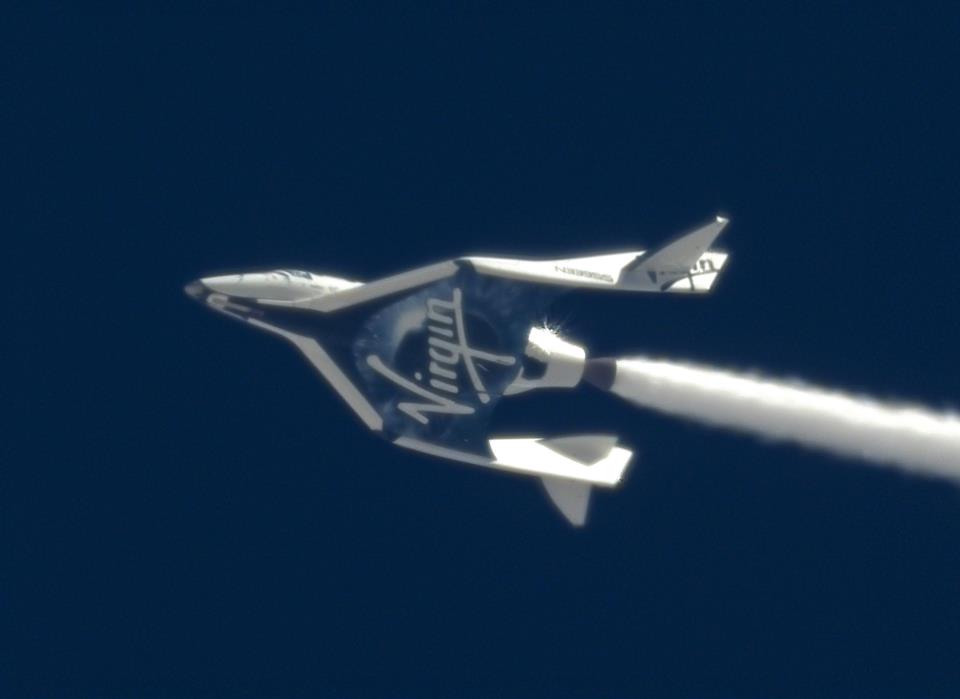Virgin Galactic's SpaceShipTwo Makes Stunning Leap Toward Private Spaceflight (Photo)

A new private spaceship is one step closer to flying its first passengers after acing a spectacular test flight over the California desert last week.
Virgin Galactic's suborbital SpaceShipTwo successfully conducted its first "cold flow" flight test above the Mojave Desert last Friday (April 12). During the test, oxidizer was run through the rocket's propulsion system and out the back nozzle of the ship, though the vehicle's rocket engine was not turned on.
"As well as providing further qualifying evidence that the rocket system is flight-ready, the test also provided a stunning spectacle due to the oxidizer contrail and for the first time gave a taste of what SpaceShipTwo will look like as it powers to space," Virgin Galactic officials wrote in a statement. [See Photos of Virgin Galactic's Test Flights ]
During the most recent test — which comes on the heels of the ship's 24th successful drop test on April 3 — the space plane was flown high into the sky by WhiteKnightTwo, its carrier aircraft. After being released from the plane, SpaceShipTwo glided smoothly back to the ground, leaving a contrail of oxidizer in its wake.
The next big step for the commercial spaceflight company appears to be conducting a full flight test, igniting the rocket in the air.
"The upcoming first powered flight of SpaceshipTwo is in many ways the most significant milestone to date, being the first time that the spaceship has flown with all systems installed and fully operational," Virgin Galactic officials wrote.
The company has not released an expected date for a powered test flight.
Get the Space.com Newsletter
Breaking space news, the latest updates on rocket launches, skywatching events and more!
Once SpaceShipTwo is operational, WhiteKnightTwo will carry the vehicle up to an altitude of about 50,000 feet (15,240 meters) before releasing it.
After separation, SpaceShipTwo will accelerate to 2,500 mph (4,000 km/h) and eventually pass an altitude of 62 miles (100 kilometers), the point at which passengers are considered astronauts. The spaceship will reach a peak altitude of 68 miles (110 km), giving the six passengers and two pilots about five minutes of weightlessness. Upon re-entry, SpaceShipTwo will be able to land on a conventional runway.
A seat on board a SpaceShipTwo flight costs $200,000. More than 550 people have put down deposits to reserve a spot, company officials say.
Virgin Galactic was founded by British billionaire Sir Richard Branson in 2004 to offer private trips to space for paying passengers. The company's SpaceShipTwo vehicles and their giant WhiteKnightTwo carrier aircraft were developed by the Mojave, Calif.-based company Scaled Composites.
Follow Miriam Kramer on Twitter and Google+. Follow us on Twitter, Facebook and Google+. Original article on SPACE.com.
Join our Space Forums to keep talking space on the latest missions, night sky and more! And if you have a news tip, correction or comment, let us know at: community@space.com.

Miriam Kramer joined Space.com as a Staff Writer in December 2012. Since then, she has floated in weightlessness on a zero-gravity flight, felt the pull of 4-Gs in a trainer aircraft and watched rockets soar into space from Florida and Virginia. She also served as Space.com's lead space entertainment reporter, and enjoys all aspects of space news, astronomy and commercial spaceflight. Miriam has also presented space stories during live interviews with Fox News and other TV and radio outlets. She originally hails from Knoxville, Tennessee where she and her family would take trips to dark spots on the outskirts of town to watch meteor showers every year. She loves to travel and one day hopes to see the northern lights in person. Miriam is currently a space reporter with Axios, writing the Axios Space newsletter. You can follow Miriam on Twitter.